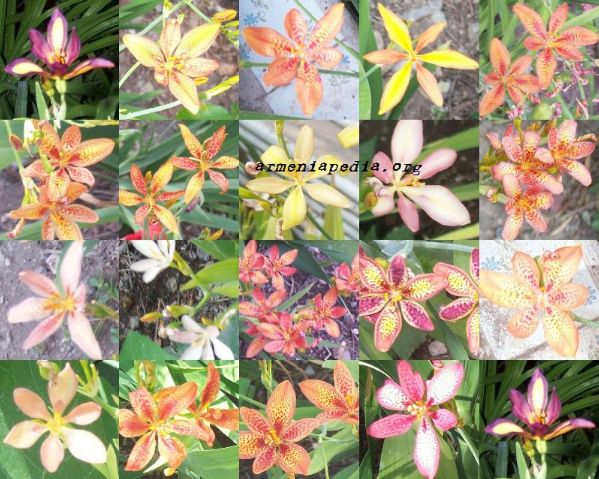Candy lily: Difference between revisions
No edit summary |
No edit summary |
||
| Line 1: | Line 1: | ||
{{SPlantbox | |||
|familia=Iridaceae | |||
|genus=Pardancanda | |||
|species=norrisii | |||
|common_name=Candy Lily | |||
|habit=herbaceous | |||
|Max ht box=2 | |||
|Max ht metric=ft | |||
|Max wd box=1.5 | |||
|Max wd metric=ft | |||
|origin=Garden origin | |||
|lifespan=perennial | |||
|exposure=sun, part-sun | |||
|water=moderate, dry | |||
|features=flowers | |||
|flower_season=mid summer, late summer | |||
|flowers=red, orange, yellow, purple, brown, multicolored, pink, white, spotted | |||
|Temp Metric=°F | |||
|min_zone=5 | |||
|max_zone=12 | |||
|image=Pardancanda_CIMG4656.JPG | |||
|image_width=240 | |||
}} | |||
Candy lily flowers closely resemble those of [[Belamcanda]]. It is a bigeneric genus (Belamcanda chinensis x Pardanthopsis dichotoma). [[Flower]]s primarily bloom in July-August, with some sporadic continued bloom to frost. Each flower lasts only one day. Sword-shaped, iris-like leaves. Flowers are followed by seedpods which resemble [[blackberry|blackberries]] and provide some interest in autumn. | |||
Starry flowers in single colors, tiger stripes and spotted. Colors range from yellow, red, salmon , pink, or white shades. Iris-like foliage. Tolerates heat and drought well. | |||
Often misspelled Pardancanda norisii, the plant commonly known as the Candy Lily was probably first introduced to the world by Park Seed Company. | Often misspelled Pardancanda norisii, the plant commonly known as the Candy Lily was probably first introduced to the world by Park Seed Company. | ||
[[Image:Pardancanda-collage.jpg|center|Collage of Pardancanda blooms in Raffi's Yerevan garden in 2004.]]<br clear=all> | |||
==Cultivation== | |||
Best grown in dry to medium moisture, well-drained soils in full sun to part shade. Best in full sun. Tolerates summer heat and drought. Prefers sandy, humusy soils. Appreciates a light winter mulch in [[USDA Zone]] 5. | |||
===Propagation=== | |||
===Pests and diseases=== | |||
No serious insect or disease problems. | |||
==Varieties== | |||
'Dazzler' is a dwarf strain which features 6-petaled, saucer-shaped flowers (2" across) in a variety of colors including yellow, orange, pink, purple and red on scapes growing to 16" tall. | |||
==Gallery== | |||
<gallery perrow=5> | |||
Image:Upload.png| photo 1 | |||
Image:Upload.png| photo 2 | |||
Image:Upload.png| photo 3 | |||
</gallery> | |||
==References== | |||
<references/> | |||
*[[Standard Cyclopedia of Horticulture]], by L. H. Bailey, MacMillan Co., 1963 | |||
<!--- xxxxx *Flora: The Gardener's Bible, by Sean Hogan. Global Book Publishing, 2003. ISBN 0881925381 --> | |||
<!--- xxxxx *American Horticultural Society: A-Z Encyclopedia of Garden Plants, by Christopher Brickell, Judith D. Zuk. 1996. ISBN 0789419432 --> | |||
<!--- xxxxx *Sunset National Garden Book. Sunset Books, Inc., 1997. ISBN 0376038608 --> | |||
==External links== | |||
*{{wplink}} | |||
{{stub}} | |||
__NOTOC__ | |||
Revision as of 15:50, 25 February 2010
| Pardancanda norrisii subsp. var. | Candy Lily | |||||||||||||||||||||||||||||||||||||||||||||||||||||||
|---|---|---|---|---|---|---|---|---|---|---|---|---|---|---|---|---|---|---|---|---|---|---|---|---|---|---|---|---|---|---|---|---|---|---|---|---|---|---|---|---|---|---|---|---|---|---|---|---|---|---|---|---|---|---|---|---|
| File:Pardancanda CIMG4656.JPG |
|
| ||||||||||||||||||||||||||||||||||||||||||||||||||||||
| ||||||||||||||||||||||||||||||||||||||||||||||||||||||||
Candy lily flowers closely resemble those of Belamcanda. It is a bigeneric genus (Belamcanda chinensis x Pardanthopsis dichotoma). Flowers primarily bloom in July-August, with some sporadic continued bloom to frost. Each flower lasts only one day. Sword-shaped, iris-like leaves. Flowers are followed by seedpods which resemble blackberries and provide some interest in autumn.
Starry flowers in single colors, tiger stripes and spotted. Colors range from yellow, red, salmon , pink, or white shades. Iris-like foliage. Tolerates heat and drought well.
Often misspelled Pardancanda norisii, the plant commonly known as the Candy Lily was probably first introduced to the world by Park Seed Company.

Cultivation
Best grown in dry to medium moisture, well-drained soils in full sun to part shade. Best in full sun. Tolerates summer heat and drought. Prefers sandy, humusy soils. Appreciates a light winter mulch in USDA Zone 5.
Propagation
Pests and diseases
No serious insect or disease problems.
Varieties
'Dazzler' is a dwarf strain which features 6-petaled, saucer-shaped flowers (2" across) in a variety of colors including yellow, orange, pink, purple and red on scapes growing to 16" tall.
Gallery
-
photo 1
-
photo 2
-
photo 3
References
- Standard Cyclopedia of Horticulture, by L. H. Bailey, MacMillan Co., 1963
External links
- w:Candy lily. Some of the material on this page may be from Wikipedia, under the Creative Commons license.
- Candy lily QR Code (Size 50, 100, 200, 500)
